2016 NISSAN LEAF climate control
[x] Cancel search: climate controlPage 264 of 437
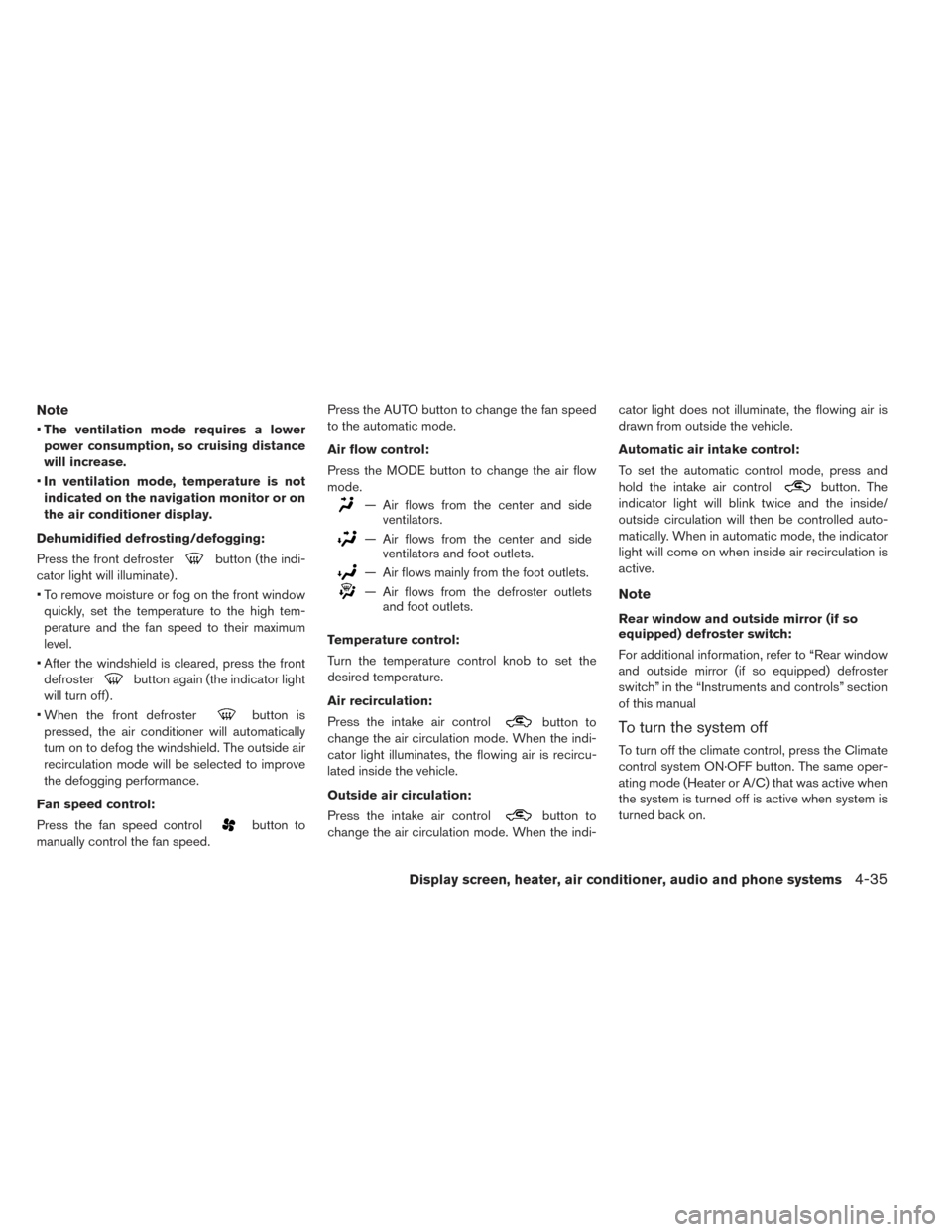
Note
•The ventilation mode requires a lower
power consumption, so cruising distance
will increase.
• In ventilation mode, temperature is not
indicated on the navigation monitor or on
the air conditioner display.
Dehumidified defrosting/defogging:
Press the front defroster
button (the indi-
cator light will illuminate) .
• To remove moisture or fog on the front window quickly, set the temperature to the high tem-
perature and the fan speed to their maximum
level.
• After the windshield is cleared, press the front defroster
button again (the indicator light
will turn off) .
• When the front defroster
button is
pressed, the air conditioner will automatically
turn on to defog the windshield. The outside air
recirculation mode will be selected to improve
the defogging performance.
Fan speed control:
Press the fan speed control
button to
manually control the fan speed. Press the AUTO button to change the fan speed
to the automatic mode.
Air flow control:
Press the MODE button to change the air flow
mode.
— Air flows from the center and side
ventilators.
— Air flows from the center and sideventilators and foot outlets.
— Air flows mainly from the foot outlets.
— Air flows from the defroster outletsand foot outlets.
Temperature control:
Turn the temperature control knob to set the
desired temperature.
Air recirculation:
Press the intake air control
button to
change the air circulation mode. When the indi-
cator light illuminates, the flowing air is recircu-
lated inside the vehicle.
Outside air circulation:
Press the intake air control
button to
change the air circulation mode. When the indi- cator light does not illuminate, the flowing air is
drawn from outside the vehicle.
Automatic air intake control:
To set the automatic control mode, press and
hold the intake air control
button. The
indicator light will blink twice and the inside/
outside circulation will then be controlled auto-
matically. When in automatic mode, the indicator
light will come on when inside air recirculation is
active.
Note
Rear window and outside mirror (if so
equipped) defroster switch:
For additional information, refer to “Rear window
and outside mirror (if so equipped) defroster
switch” in the “Instruments and controls” section
of this manual
To turn the system off
To turn off the climate control, press the Climate
control system ON·OFF button. The same oper-
ating mode (Heater or A/C) that was active when
the system is turned off is active when system is
turned back on.
Display screen, heater, air conditioner, audio and phone systems4-35
Page 265 of 437
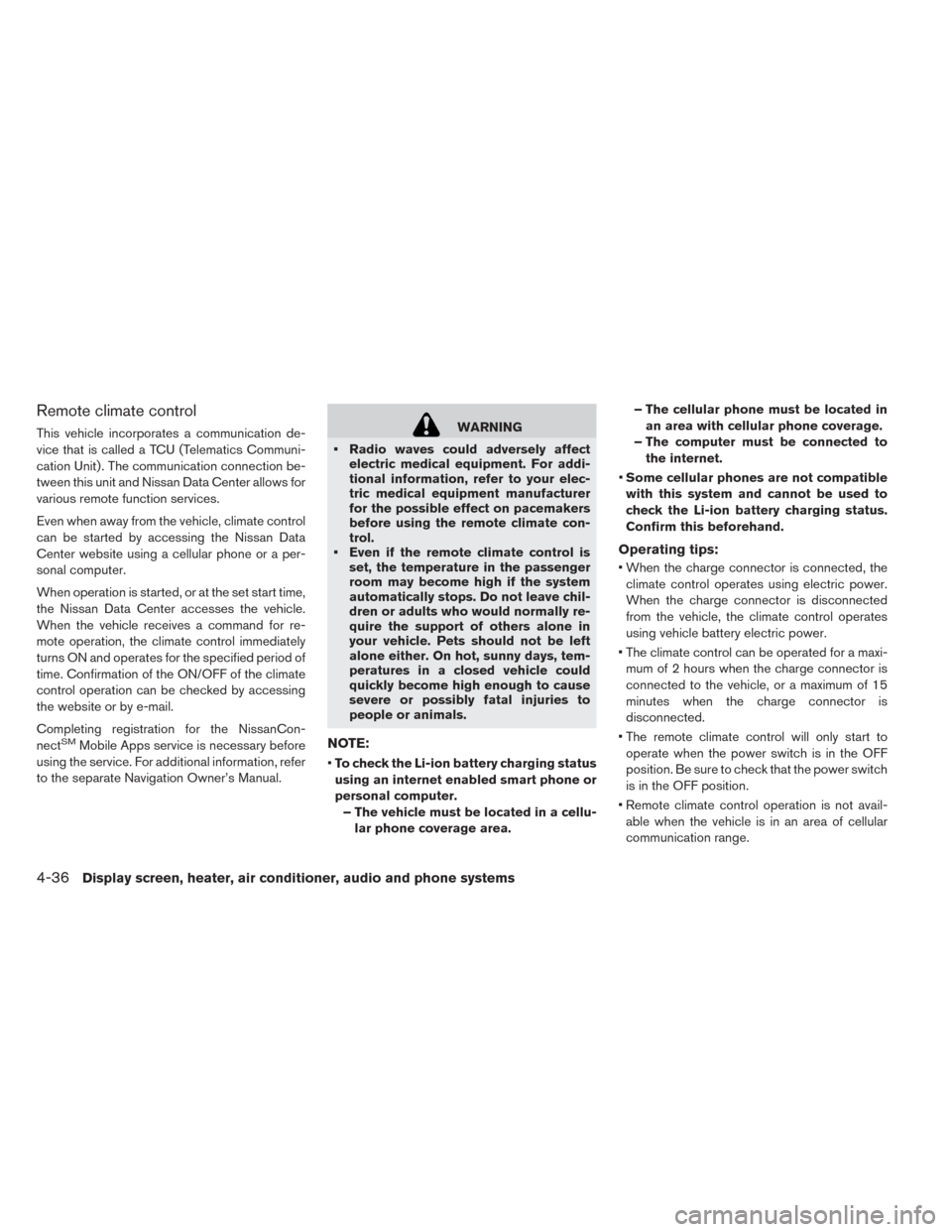
Remote climate control
This vehicle incorporates a communication de-
vice that is called a TCU (Telematics Communi-
cation Unit) . The communication connection be-
tween this unit and Nissan Data Center allows for
various remote function services.
Even when away from the vehicle, climate control
can be started by accessing the Nissan Data
Center website using a cellular phone or a per-
sonal computer.
When operation is started, or at the set start time,
the Nissan Data Center accesses the vehicle.
When the vehicle receives a command for re-
mote operation, the climate control immediately
turns ON and operates for the specified period of
time. Confirmation of the ON/OFF of the climate
control operation can be checked by accessing
the website or by e-mail.
Completing registration for the NissanCon-
nect
SMMobile Apps service is necessary before
using the service. For additional information, refer
to the separate Navigation Owner’s Manual.
WARNING
• Radio waves could adversely affect electric medical equipment. For addi-
tional information, refer to your elec-
tric medical equipment manufacturer
for the possible effect on pacemakers
before using the remote climate con-
trol.
• Even if the remote climate control is set, the temperature in the passenger
room may become high if the system
automatically stops. Do not leave chil-
dren or adults who would normally re-
quire the support of others alone in
your vehicle. Pets should not be left
alone either. On hot, sunny days, tem-
peratures in a closed vehicle could
quickly become high enough to cause
severe or possibly fatal injuries to
people or animals.
NOTE:
•To check the Li-ion battery charging status
using an internet enabled smart phone or
personal computer. – The vehicle must be located in a cellu- lar phone coverage area. – The cellular phone must be located in
an area with cellular phone coverage.
– The computer must be connected to the internet.
• Some cellular phones are not compatible
with this system and cannot be used to
check the Li-ion battery charging status.
Confirm this beforehand.
Operating tips:
• When the charge connector is connected, the climate control operates using electric power.
When the charge connector is disconnected
from the vehicle, the climate control operates
using vehicle battery electric power.
• The climate control can be operated for a maxi- mum of 2 hours when the charge connector is
connected to the vehicle, or a maximum of 15
minutes when the charge connector is
disconnected.
• The remote climate control will only start to operate when the power switch is in the OFF
position. Be sure to check that the power switch
is in the OFF position.
• Remote climate control operation is not avail- able when the vehicle is in an area of cellular
communication range.
4-36Display screen, heater, air conditioner, audio and phone systems
Page 266 of 437
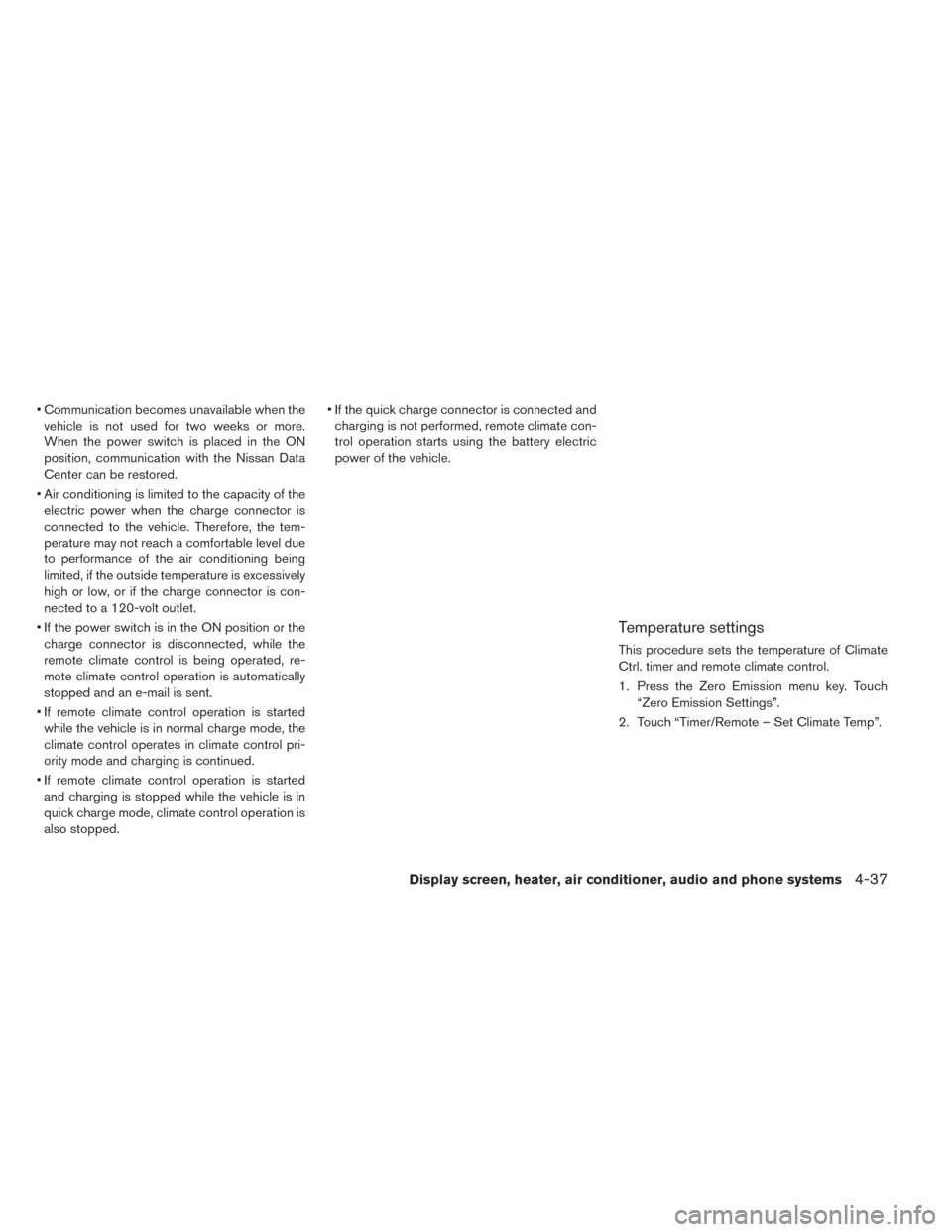
• Communication becomes unavailable when thevehicle is not used for two weeks or more.
When the power switch is placed in the ON
position, communication with the Nissan Data
Center can be restored.
• Air conditioning is limited to the capacity of the electric power when the charge connector is
connected to the vehicle. Therefore, the tem-
perature may not reach a comfortable level due
to performance of the air conditioning being
limited, if the outside temperature is excessively
high or low, or if the charge connector is con-
nected to a 120-volt outlet.
• If the power switch is in the ON position or the charge connector is disconnected, while the
remote climate control is being operated, re-
mote climate control operation is automatically
stopped and an e-mail is sent.
• If remote climate control operation is started while the vehicle is in normal charge mode, the
climate control operates in climate control pri-
ority mode and charging is continued.
• If remote climate control operation is started and charging is stopped while the vehicle is in
quick charge mode, climate control operation is
also stopped. • If the quick charge connector is connected and
charging is not performed, remote climate con-
trol operation starts using the battery electric
power of the vehicle.
Temperature settings
This procedure sets the temperature of Climate
Ctrl. timer and remote climate control.
1. Press the Zero Emission menu key. Touch “Zero Emission Settings”.
2. Touch “Timer/Remote – Set Climate Temp”.
Display screen, heater, air conditioner, audio and phone systems4-37
Page 267 of 437
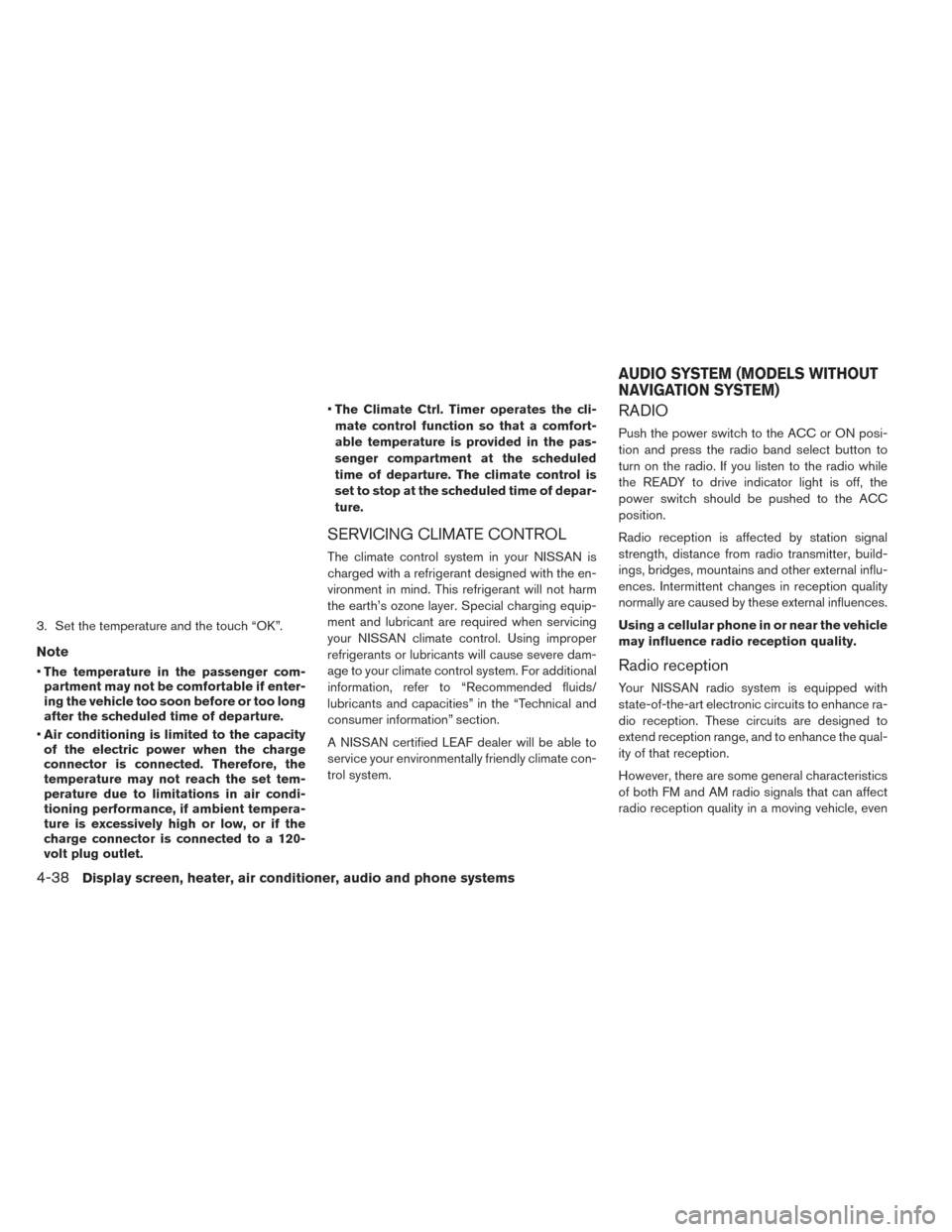
3. Set the temperature and the touch “OK”.
Note
•The temperature in the passenger com-
partment may not be comfortable if enter-
ing the vehicle too soon before or too long
after the scheduled time of departure.
• Air conditioning is limited to the capacity
of the electric power when the charge
connector is connected. Therefore, the
temperature may not reach the set tem-
perature due to limitations in air condi-
tioning performance, if ambient tempera-
ture is excessively high or low, or if the
charge connector is connected to a 120-
volt plug outlet. •
The Climate Ctrl. Timer operates the cli-
mate control function so that a comfort-
able temperature is provided in the pas-
senger compartment at the scheduled
time of departure. The climate control is
set to stop at the scheduled time of depar-
ture.
SERVICING CLIMATE CONTROL
The climate control system in your NISSAN is
charged with a refrigerant designed with the en-
vironment in mind. This refrigerant will not harm
the earth’s ozone layer. Special charging equip-
ment and lubricant are required when servicing
your NISSAN climate control. Using improper
refrigerants or lubricants will cause severe dam-
age to your climate control system. For additional
information, refer to “Recommended fluids/
lubricants and capacities” in the “Technical and
consumer information” section.
A NISSAN certified LEAF dealer will be able to
service your environmentally friendly climate con-
trol system.
RADIO
Push the power switch to the ACC or ON posi-
tion and press the radio band select button to
turn on the radio. If you listen to the radio while
the READY to drive indicator light is off, the
power switch should be pushed to the ACC
position.
Radio reception is affected by station signal
strength, distance from radio transmitter, build-
ings, bridges, mountains and other external influ-
ences. Intermittent changes in reception quality
normally are caused by these external influences.
Using a cellular phone in or near the vehicle
may influence radio reception quality.
Radio reception
Your NISSAN radio system is equipped with
state-of-the-art electronic circuits to enhance ra-
dio reception. These circuits are designed to
extend reception range, and to enhance the qual-
ity of that reception.
However, there are some general characteristics
of both FM and AM radio signals that can affect
radio reception quality in a moving vehicle, even
AUDIO SYSTEM (MODELS WITHOUT
NAVIGATION SYSTEM)
4-38Display screen, heater, air conditioner, audio and phone systems
Page 326 of 437
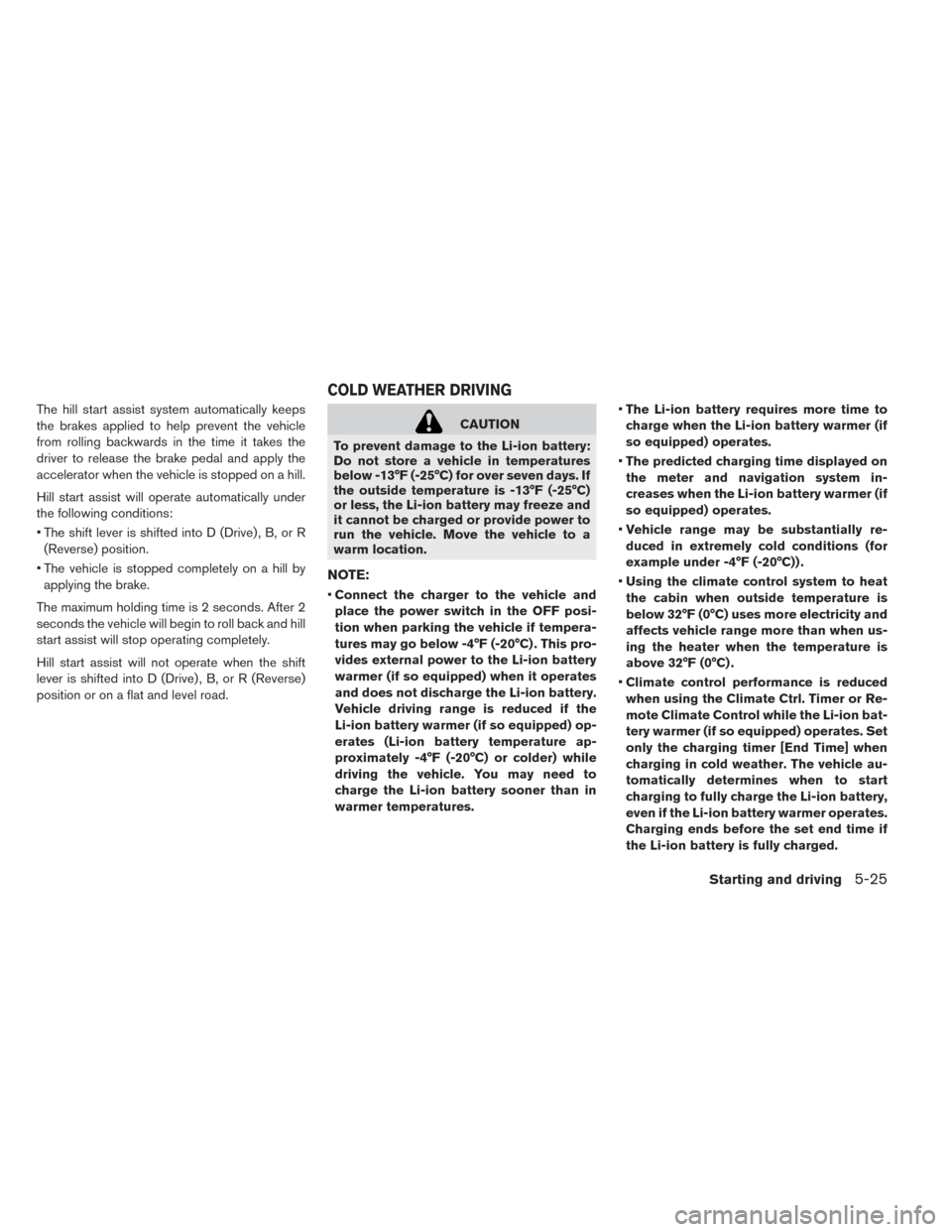
The hill start assist system automatically keeps
the brakes applied to help prevent the vehicle
from rolling backwards in the time it takes the
driver to release the brake pedal and apply the
accelerator when the vehicle is stopped on a hill.
Hill start assist will operate automatically under
the following conditions:
• The shift lever is shifted into D (Drive) , B, or R(Reverse) position.
• The vehicle is stopped completely on a hill by applying the brake.
The maximum holding time is 2 seconds. After 2
seconds the vehicle will begin to roll back and hill
start assist will stop operating completely.
Hill start assist will not operate when the shift
lever is shifted into D (Drive) , B, or R (Reverse)
position or on a flat and level road.CAUTION
To prevent damage to the Li-ion battery:
Do not store a vehicle in temperatures
below -13°F (-25°C) for over seven days. If
the outside temperature is -13°F (-25°C)
or less, the Li-ion battery may freeze and
it cannot be charged or provide power to
run the vehicle. Move the vehicle to a
warm location.
NOTE:
• Connect the charger to the vehicle and
place the power switch in the OFF posi-
tion when parking the vehicle if tempera-
tures may go below -4°F (-20°C) . This pro-
vides external power to the Li-ion battery
warmer (if so equipped) when it operates
and does not discharge the Li-ion battery.
Vehicle driving range is reduced if the
Li-ion battery warmer (if so equipped) op-
erates (Li-ion battery temperature ap-
proximately -4°F (-20°C) or colder) while
driving the vehicle. You may need to
charge the Li-ion battery sooner than in
warmer temperatures. •
The Li-ion battery requires more time to
charge when the Li-ion battery warmer (if
so equipped) operates.
• The predicted charging time displayed on
the meter and navigation system in-
creases when the Li-ion battery warmer (if
so equipped) operates.
• Vehicle range may be substantially re-
duced in extremely cold conditions (for
example under -4°F (-20°C)) .
• Using the climate control system to heat
the cabin when outside temperature is
below 32°F (0°C) uses more electricity and
affects vehicle range more than when us-
ing the heater when the temperature is
above 32°F (0°C) .
• Climate control performance is reduced
when using the Climate Ctrl. Timer or Re-
mote Climate Control while the Li-ion bat-
tery warmer (if so equipped) operates. Set
only the charging timer [End Time] when
charging in cold weather. The vehicle au-
tomatically determines when to start
charging to fully charge the Li-ion battery,
even if the Li-ion battery warmer operates.
Charging ends before the set end time if
the Li-ion battery is fully charged.
COLD WEATHER DRIVING
Starting and driving5-25
Page 405 of 437
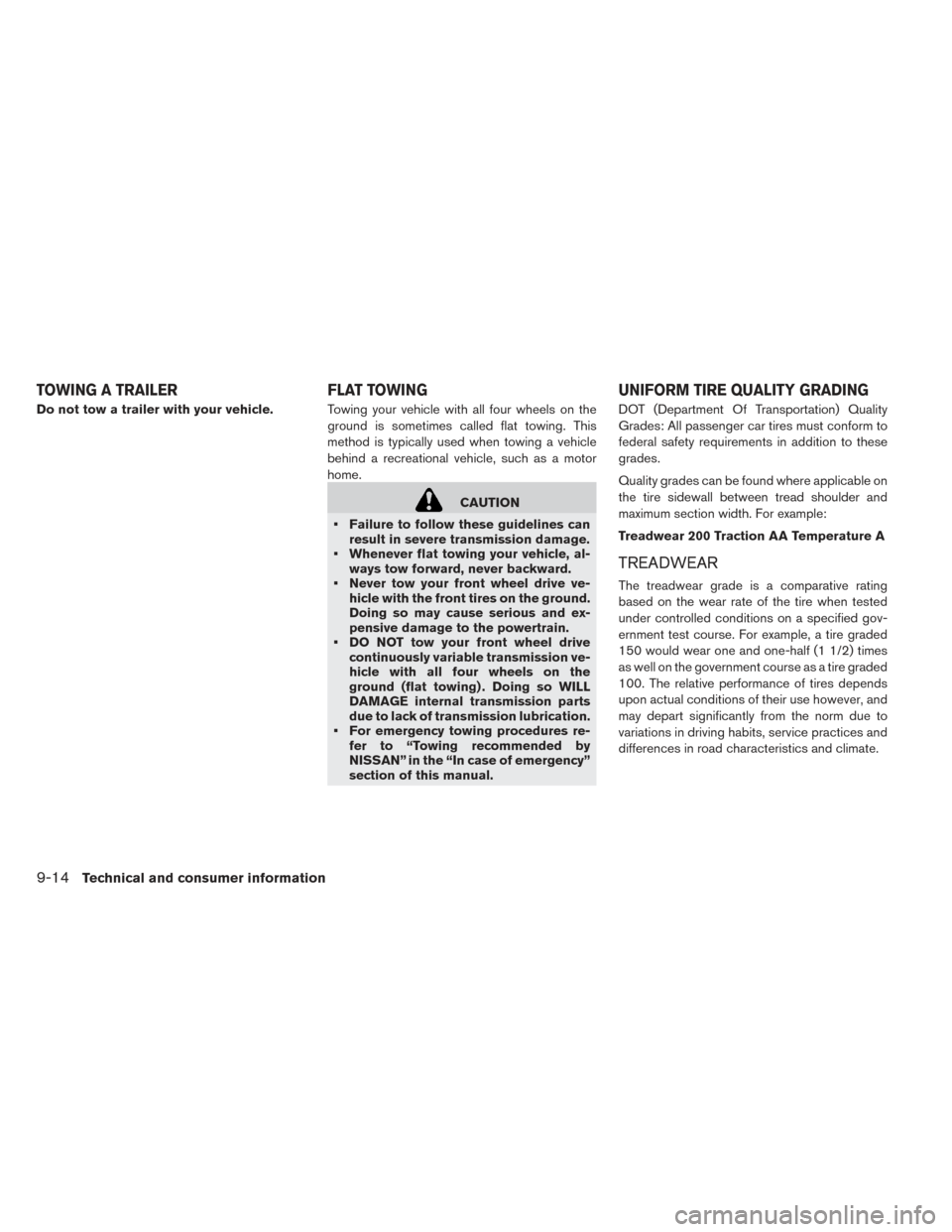
Do not tow a trailer with your vehicle.Towing your vehicle with all four wheels on the
ground is sometimes called flat towing. This
method is typically used when towing a vehicle
behind a recreational vehicle, such as a motor
home.
CAUTION
• Failure to follow these guidelines can result in severe transmission damage.
• Whenever flat towing your vehicle, al- ways tow forward, never backward.
• Never tow your front wheel drive ve- hicle with the front tires on the ground.
Doing so may cause serious and ex-
pensive damage to the powertrain.
• DO NOT tow your front wheel drive continuously variable transmission ve-
hicle with all four wheels on the
ground (flat towing) . Doing so WILL
DAMAGE internal transmission parts
due to lack of transmission lubrication.
• For emergency towing procedures re- fer to “Towing recommended by
NISSAN” in the “In case of emergency”
section of this manual. DOT (Department Of Transportation) Quality
Grades: All passenger car tires must conform to
federal safety requirements in addition to these
grades.
Quality grades can be found where applicable on
the tire sidewall between tread shoulder and
maximum section width. For example:
Treadwear 200 Traction AA Temperature A
TREADWEAR
The treadwear grade is a comparative rating
based on the wear rate of the tire when tested
under controlled conditions on a specified gov-
ernment test course. For example, a tire graded
150 would wear one and one-half (1 1/2) times
as well on the government course as a tire graded
100. The relative performance of tires depends
upon actual conditions of their use however, and
may depart significantly from the norm due to
variations in driving habits, service practices and
differences in road characteristics and climate.
TOWING A TRAILER
FLAT TOWINGUNIFORM TIRE QUALITY GRADING
9-14Technical and consumer information
Page 408 of 437
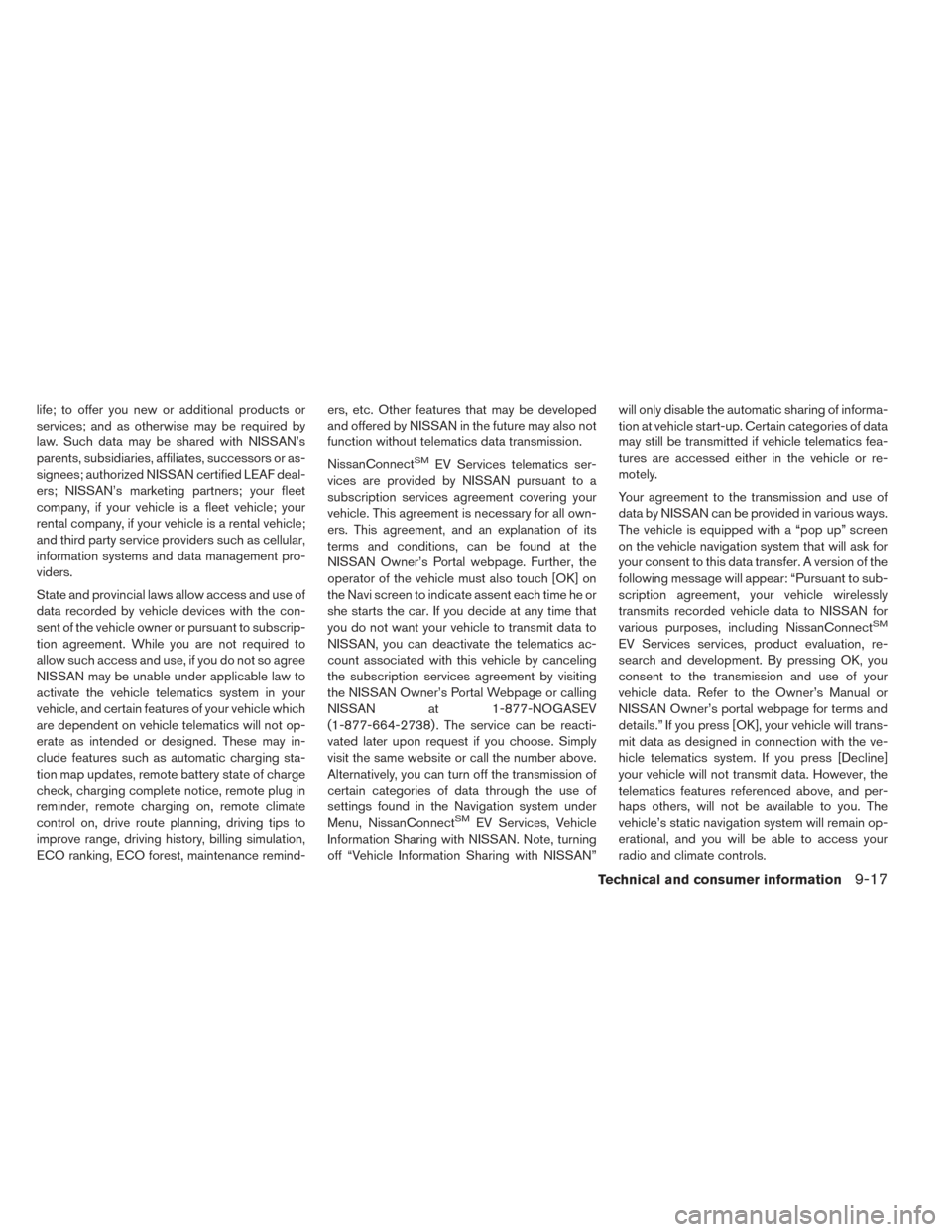
life; to offer you new or additional products or
services; and as otherwise may be required by
law. Such data may be shared with NISSAN’s
parents, subsidiaries, affiliates, successors or as-
signees; authorized NISSAN certified LEAF deal-
ers; NISSAN’s marketing partners; your fleet
company, if your vehicle is a fleet vehicle; your
rental company, if your vehicle is a rental vehicle;
and third party service providers such as cellular,
information systems and data management pro-
viders.
State and provincial laws allow access and use of
data recorded by vehicle devices with the con-
sent of the vehicle owner or pursuant to subscrip-
tion agreement. While you are not required to
allow such access and use, if you do not so agree
NISSAN may be unable under applicable law to
activate the vehicle telematics system in your
vehicle, and certain features of your vehicle which
are dependent on vehicle telematics will not op-
erate as intended or designed. These may in-
clude features such as automatic charging sta-
tion map updates, remote battery state of charge
check, charging complete notice, remote plug in
reminder, remote charging on, remote climate
control on, drive route planning, driving tips to
improve range, driving history, billing simulation,
ECO ranking, ECO forest, maintenance remind-ers, etc. Other features that may be developed
and offered by NISSAN in the future may also not
function without telematics data transmission.
NissanConnect
SMEV Services telematics ser-
vices are provided by NISSAN pursuant to a
subscription services agreement covering your
vehicle. This agreement is necessary for all own-
ers. This agreement, and an explanation of its
terms and conditions, can be found at the
NISSAN Owner’s Portal webpage. Further, the
operator of the vehicle must also touch [OK] on
the Navi screen to indicate assent each time he or
she starts the car. If you decide at any time that
you do not want your vehicle to transmit data to
NISSAN, you can deactivate the telematics ac-
count associated with this vehicle by canceling
the subscription services agreement by visiting
the NISSAN Owner’s Portal Webpage or calling
NISSAN at 1-877-NOGASEV
(1-877-664-2738) . The service can be reacti-
vated later upon request if you choose. Simply
visit the same website or call the number above.
Alternatively, you can turn off the transmission of
certain categories of data through the use of
settings found in the Navigation system under
Menu, NissanConnect
SMEV Services, Vehicle
Information Sharing with NISSAN. Note, turning
off “Vehicle Information Sharing with NISSAN” will only disable the automatic sharing of informa-
tion at vehicle start-up. Certain categories of data
may still be transmitted if vehicle telematics fea-
tures are accessed either in the vehicle or re-
motely.
Your agreement to the transmission and use of
data by NISSAN can be provided in various ways.
The vehicle is equipped with a “pop up” screen
on the vehicle navigation system that will ask for
your consent to this data transfer. A version of the
following message will appear: “Pursuant to sub-
scription agreement, your vehicle wirelessly
transmits recorded vehicle data to NISSAN for
various purposes, including NissanConnect
SM
EV Services services, product evaluation, re-
search and development. By pressing OK, you
consent to the transmission and use of your
vehicle data. Refer to the Owner’s Manual or
NISSAN Owner’s portal webpage for terms and
details.” If you press [OK], your vehicle will trans-
mit data as designed in connection with the ve-
hicle telematics system. If you press [Decline]
your vehicle will not transmit data. However, the
telematics features referenced above, and per-
haps others, will not be available to you. The
vehicle’s static navigation system will remain op-
erational, and you will be able to access your
radio and climate controls.
Technical and consumer information9-17
Page 414 of 437

10 Index
A
ABS (Anti-lock Braking System)........5-22
Advanced air bag system ...........1-44
Air bag system .................1-44
Advanced air bag system ..........1-44
Front passenger air bag and status light. .1-45
Front-seat mounted side-impact
supplemental air bag system ........1-51
Roof-mounted curtain side-impact
supplemental air bag system ........1-51
Airbagwarninglabels.............1-54
Airbagwarninglight...........1-54,2-19
Air conditioner .................9-10
Air conditioner specification label .....9-10
Air conditioning system refrigerant and
lubricant recommendations .........9-4
Alarm, How to stop alarm
(refer to, vehicle security system) .......2-37
Alcohol, drugs and driving ............5-7
Anti-lock Braking System (ABS) ........5-22
Anti-lock Braking System (ABS) warning
light .......................2-14
Appearance care .................7-2
Exterior appearance care ...........7-2
Interior appearance care ...........7-4
Audible reminders ...............2-21
Autolight system ................2-42 Automatic.....................3-6
Door locks ...................3-6
Automatic climate control
(models with Navigation System) .......4-33
Automatic climate control
(models without Navigation System) .....4-26
Avoiding collision and rollover ..........5-5
B
Battery......................8-12
12-volt battery ................8-12
Battery saver system ............2-44
Intelligent Key battery ............8-20
Li-ion battery .................EV-2
Li-ion battery temperature gauge ......2-6
Before starting system .............5-11
Boosterseats..................1-35
Brake ......................5-15 Anti-lock Braking System (ABS) ......5-22
Brakefluid..................8-10
Brakes....................8-16
Brake system ................5-20
BRAKE system warning light (yellow) . . .2-14
BRAKE warning light (red) .........2-15
BRAKE system warning light (yellow) .....2-14
BRAKE warning light (red) ...........2-15
Bulb replacement ................8-22
C
Ceiling light...................2-58
Charge .....................2-50
Charge timer OFF switch ..........2-50
Charge connector lock switch .........2-49
Charge port lid switch .............2-49
Charging ....................3-19
Chargeportlid................3-19
Charging related indicator light .....CH-27
Chargingtimer ..............CH-21
Normalcharge ...............CH-9
Precautions on charging ..........CH-2
Quickcharge...............CH-15
Specifications .................9-5
Trickle charge ...............CH-11
Charging methods ..............CH-21
Charging related indicator light .......CH-27
Charging related remote function ......CH-26
Charging status indicator light .......CH-27
Charging timer ................CH-21
Charging troubleshooting guide .......CH-32
Checking ....................2-13
Checkingbulbs...............2-13
Checking coolant level ............8-9
Child restraints .................1-18
Boosterseats................1-35
Precautions on child restraints .......1-18